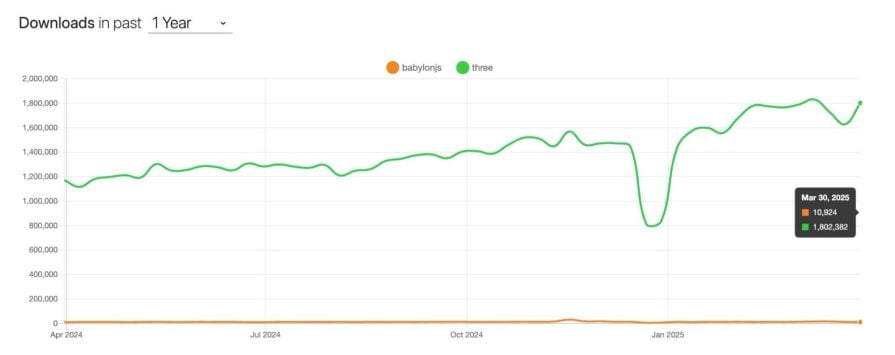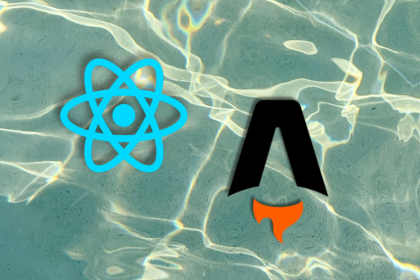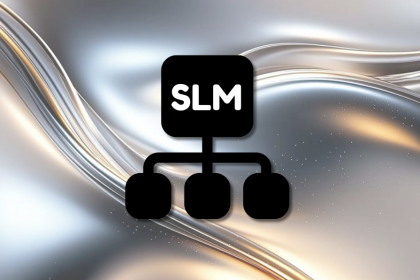
When discussing 3D web development, Three.js and Babylon.js are two libraries that tend to dominate the conversation. While both libraries support creating 3D experiences in the browser, there are a few key differences between them.

In this article, we’ll compare Three.js with Babylon.js. We’ll cover their background, how to get started with each, their core features, and key differences. In addition, we’ll provide an overview of where each library might be most useful.
The Replay is a weekly newsletter for dev and engineering leaders.
Delivered once a week, it's your curated guide to the most important conversations around frontend dev, emerging AI tools, and the state of modern software.
We’ll explore both libraries in depth in this article, but I imagine some of you are looking for a short answer. Here’s the TL;DR:
Three.js is a lightweight rendering engine; it gives you a lot of control and integrates easily with other web frameworks. However, you’ll often need third-party add-ons or custom code to handle things like physics, animation systems, or complex interactions.
Babylon.js, on the other hand, is a complete 3D engine. It comes with built-in systems for physics, animations, GUI, and most of the functionality you’d need right out of the box. With that in mind, it’s clear these two engines take very different approaches, and the rest of this article will break down those differences in detail.
Three.js was created in 2010 by Ricardo Cabello, a designer and developer who wanted to make it easier to work with WebGL. WebGL is powerful but super low-level; it’s like writing assembly for 3D graphics. Cabello’s idea was to build a higher-level API that hides all the WebGL boilerplate.
From there, Three.js started as a simple rendering engine that could draw things like cubes and spheres on a canvas. Over time, other developers jumped in and helped make it more modular and powerful. As of this writing, Three.js has over 35,000 stars on GitHub.
Getting started with Three.js is pretty straightforward; you only need to include its CDN in your bare HTML file, like below:
<script src="https://cdnjs.cloudflare.com/ajax/libs/three.js/0.174.0/three.tsl.js"></script>
Or install it via npm:
npm install three
Then import it into your project:
import * as THREE from 'three';
Once installed, you can start importing and using its features in your application. Below are some of the core ones worth exploring.
In addition to its main WebGL rendering ability that lets you display 3D graphics inside a browser canvas, Three.js provides a couple of higher-level tools out of the box. Some of them include:
That covers the basics of Three.js. Now, we’ll look at Babylon.js and then get into how they compare in terms of features and performance.
Babylon.js was started in 2013 by David Catuhe, a Microsoft engineer. It came a few years after Three.js but with a different philosophy. While Three.js focused on being a lightweight WebGL wrapper, Babylon.js went straight for the full-game engine route. Out of the box, it comes with a full physics system (via plugins like Cannon.js, Ammo.js, or Oimo.js), a powerful PBR (physically based rendering) pipeline, support for VR/AR, and a ton of editor and tooling support.
Another important factor is that Babylon.js is officially backed by Microsoft, which means more stability and active development. At the time of writing, Babylon.js has around 3.5 thousand stars on GitHub.
Getting started with Babylon.js is also easy. You can include it directly from a CDN:
<script src="https://cdn.babylonjs.com/babylon.js"></script>
Or install it via npm:
npm install babylonjs
Then import what you need for your project:
import { Scene, Engine } from 'babylonjs';
With this, you can start using Babylon’s high-level functions to build interactive 3D scenes. Let’s go over some of the most important ones.
Babylon.js comes pre-packed with features. A lot of integration you’d normally need third-party libraries for in other engines is built right in. Here are some of its biggest ones:
Before comparing them, it’s important to address that Three.js and Babylon.js are not exactly solving the same problem, so a full-blown comparison might not be fair.
Three.js is more of a lightweight rendering engine. Babylon.js, on the other hand, leans toward being a full-fledged 3D engine. That said, it’s only fair to compare them when you’re picking a tool for a specific kind of job and want to decide between flexibility vs. features or minimalism vs. tooling support.
With that in mind, here’s how both library generally compares:
| Feature | Three.js | Babylon.js |
|---|---|---|
| Ease of Use | Minimal API surface, very hands-on. You wire things together yourself. Great for devs who want control | More guided and structured. Built-in helpers, scene system, and GUI make it easier to get started fast |
| Rendering Capabilities | Strong WebGL renderer with PBR support. Very customizable; you can build your own render loop, post-processing, etc | High-quality PBR out of the box, HDR, shadows, glow layers, and a full scenegraph system. Visual fidelity is great with less setup |
| Physics Engine | Not included. You choose and integrate one yourself (like Cannon.js or Ammo.js) | Built-in integration for Cannon.js, Ammo.js, and Oimo.js. Setup is simpler and more consistent |
| Animation System | Fully featured but low-level. You can animate anything with custom code or the AnimationMixer | Built-in system supports skeletal, morph, and property animations. Also has animation blending and a visual editor via the Inspector |
| Interactivity & UI | No built-in UI system. You’d typically use DOM overlays or external libraries like dat.GUI or custom HTML | Comes with a full 2D GUI framework built into the engine e.g buttons, sliders, HUDs are all drawn in the WebGL canvas |
| WebXR & VR/AR Support | Has support via the webxr manager, but you’ll be doing some manual setup | WebXR is first-class. AR/VR setup is simpler, and Babylon even has helper scenes for XR experiences |
| Community & Documentation | Larger community, more tutorials, more third-party examples and demos. Devs use it across many types of web projects | Smaller community but great official docs. Backed by Microsoft, with consistent updates and solid long-term support |
In terms of usage, Three.js leads with over 1.8 million weekly downloads, compared to Babylon.js, which sees around 11 thousand. The graph below comes from npm trends:
 A major reason for this is how easy it is to get started with Three.js and how much it has grown on developers over time. Also, the recent trend of developers vibe coding 3D web games with AI earlier this year likely contributed to the recent spike in downloads.
A major reason for this is how easy it is to get started with Three.js and how much it has grown on developers over time. Also, the recent trend of developers vibe coding 3D web games with AI earlier this year likely contributed to the recent spike in downloads.
Per Bundlephobia, the minified + gzipped size of the latest version of Three.js (v0.175.0) is around 168.4 kB, while Babylon.js (v8.1.1) comes in at about 1.4 MB. This size difference makes sense since Babylon.js ships with more built-in features. Also, Babylon.js is modular, which means you can reduce the size by importing only what you need instead of pulling in the entire library. However, size alone doesn’t tell the whole performance story.
To make a fair comparison, we’ll render the same .glb model in both engines and measure their runtime performance – specifically FPS over time, initial load time, and general responsiveness.
I’ve put together two sample projects for this comparison. You can check them out via this GitHub repo. Each project loads the same .glb model, sets up basic lighting and a camera, and shows live FPS in the corner.
After running the test with a 19 MB Shipwreck turned into hideout model, here’s how the performance looked:
From this test, Three.js delivered slightly lower FPS and load time, which makes sense given its minimal setup. Babylon.js was marginally heavier but offered more stability during user interaction.
Choosing between Three.js and Babylon.js mostly depends on what you’re building and how much control you want. The following breakdown can help you guide that decision:
Choose Three.js if:
Choose Babylon.js if:
Three.js is mostly ideal if you want a lot of control and need to integrate smoothly with other web tools or frameworks. Babylon.js, on the other hand, is a better fit when you’d rather have more built-in functionality and don’t mind working within the structure the engine provides.
Throughout this article, we’ve explored the major differences between Three.js and Babylon.js. We’ve looked at how both libraries started, how to integrate them into your application, and their core features. We also compared their feature sets, usage over the years, performance, and where each library is best suited for different use cases.
Thanks for reading!

AI-first debugging augments traditional debugging with log clustering, pattern recognition, and faster root cause analysis. Learn where AI helps, where it fails, and how to use it safely in production.

Container queries let components respond to their own layout context instead of the viewport. This article explores how they work and where they fit alongside media queries.

React Server Components vs Islands Architecture: Learn how each reduces client JavaScript, impacts hydration and interactivity, and which trade-offs matter for production performance.

Large hosted LLMs aren’t always an option. Learn how to build agentic AI with small, local models that preserve privacy and scale.
Would you be interested in joining LogRocket's developer community?
Join LogRocket’s Content Advisory Board. You’ll help inform the type of content we create and get access to exclusive meetups, social accreditation, and swag.
Sign up now